HAT203: Analysis of Airline Industry in Hospitality Management
VerifiedAdded on 2023/01/11
|9
|1621
|85
Case Study
AI Summary
This case study analyzes the airline industry's macro and micro environments, focusing on strategic alliances. It begins with a PESTLE analysis, examining political, economic, social, technological, legal, and environmental factors influencing the industry. The micro-environment is then assessed using Porter's Five Forces framework, evaluating the power of suppliers and customers, the threat of new entrants and substitute products, and the intensity of competition. Finally, a SWOT analysis is conducted, identifying the industry's strengths (e.g., product strength, wide geographic presence), weaknesses (e.g., declining market share), opportunities (e.g., technological advancements), and threats (e.g., increasing competitive pressure). The report concludes by highlighting the challenges posed by strict regulations and the entry of low-cost airlines, which have led to strategic alliances among different airline companies.
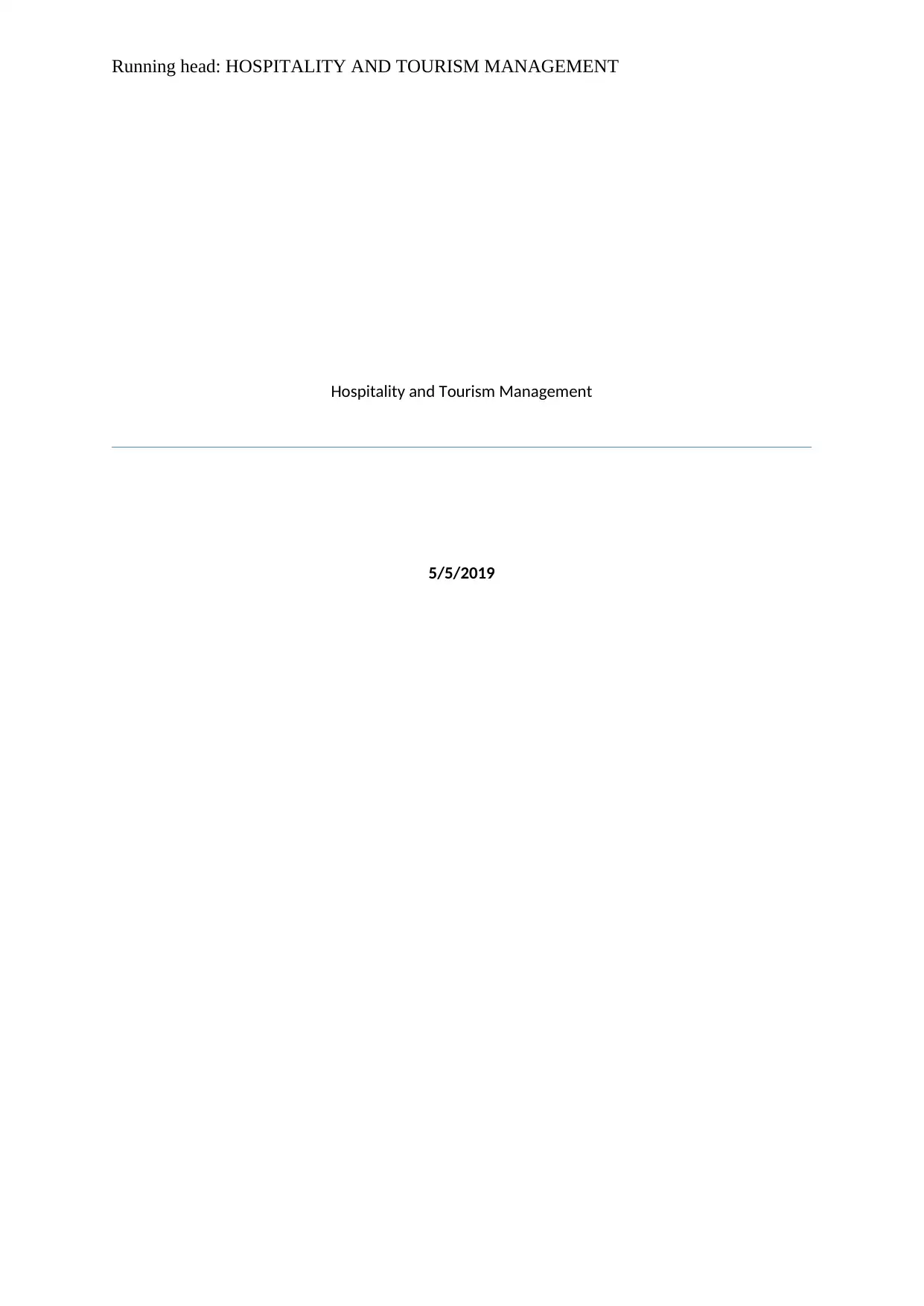
Running head: HOSPITALITY AND TOURISM MANAGEMENT
Hospitality and Tourism Management
5/5/2019
Hospitality and Tourism Management
5/5/2019
Paraphrase This Document
Need a fresh take? Get an instant paraphrase of this document with our AI Paraphraser
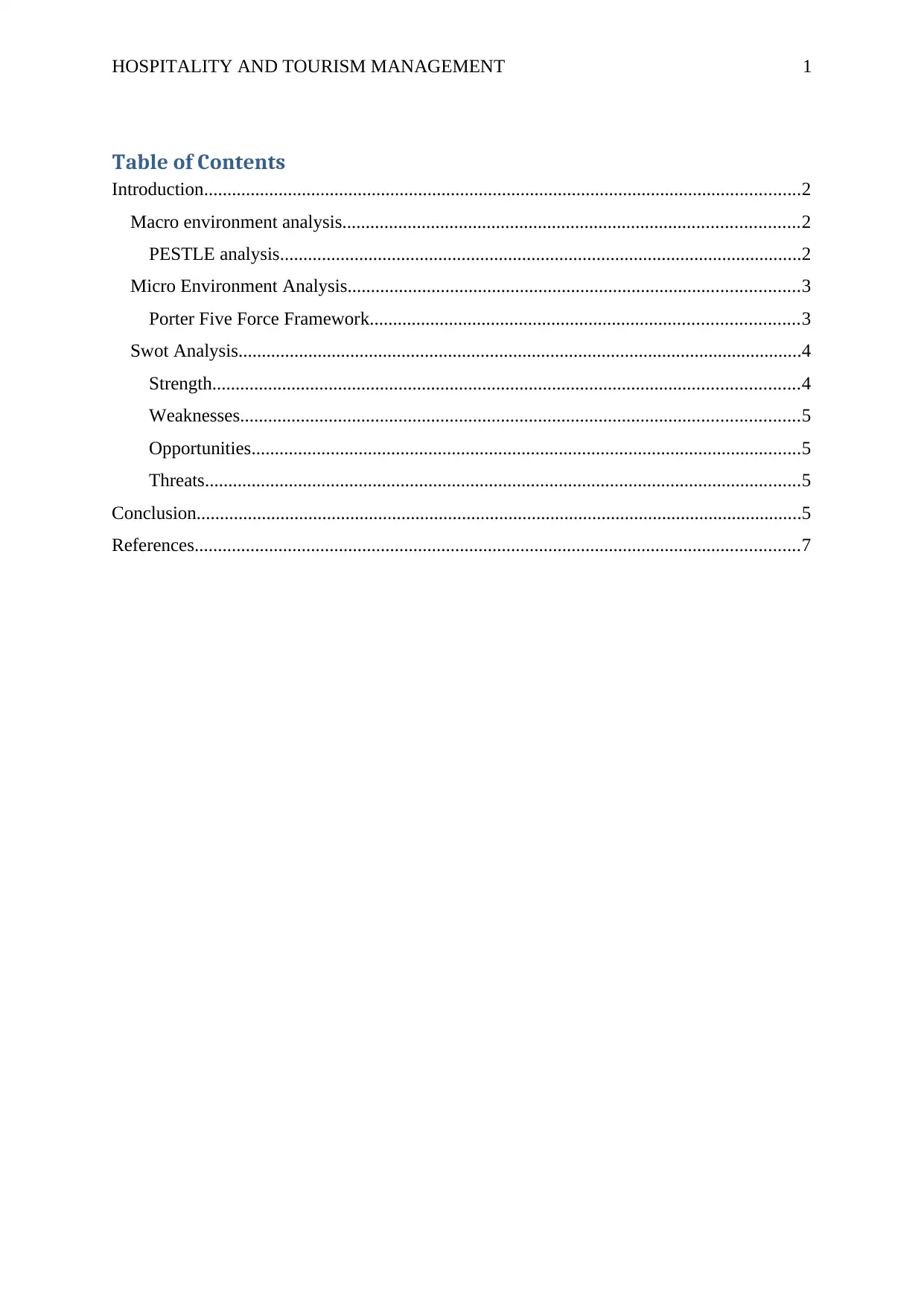
HOSPITALITY AND TOURISM MANAGEMENT 1
Table of Contents
Introduction................................................................................................................................2
Macro environment analysis..................................................................................................2
PESTLE analysis................................................................................................................2
Micro Environment Analysis.................................................................................................3
Porter Five Force Framework............................................................................................3
Swot Analysis.........................................................................................................................4
Strength..............................................................................................................................4
Weaknesses........................................................................................................................5
Opportunities......................................................................................................................5
Threats................................................................................................................................5
Conclusion..................................................................................................................................5
References..................................................................................................................................7
Table of Contents
Introduction................................................................................................................................2
Macro environment analysis..................................................................................................2
PESTLE analysis................................................................................................................2
Micro Environment Analysis.................................................................................................3
Porter Five Force Framework............................................................................................3
Swot Analysis.........................................................................................................................4
Strength..............................................................................................................................4
Weaknesses........................................................................................................................5
Opportunities......................................................................................................................5
Threats................................................................................................................................5
Conclusion..................................................................................................................................5
References..................................................................................................................................7
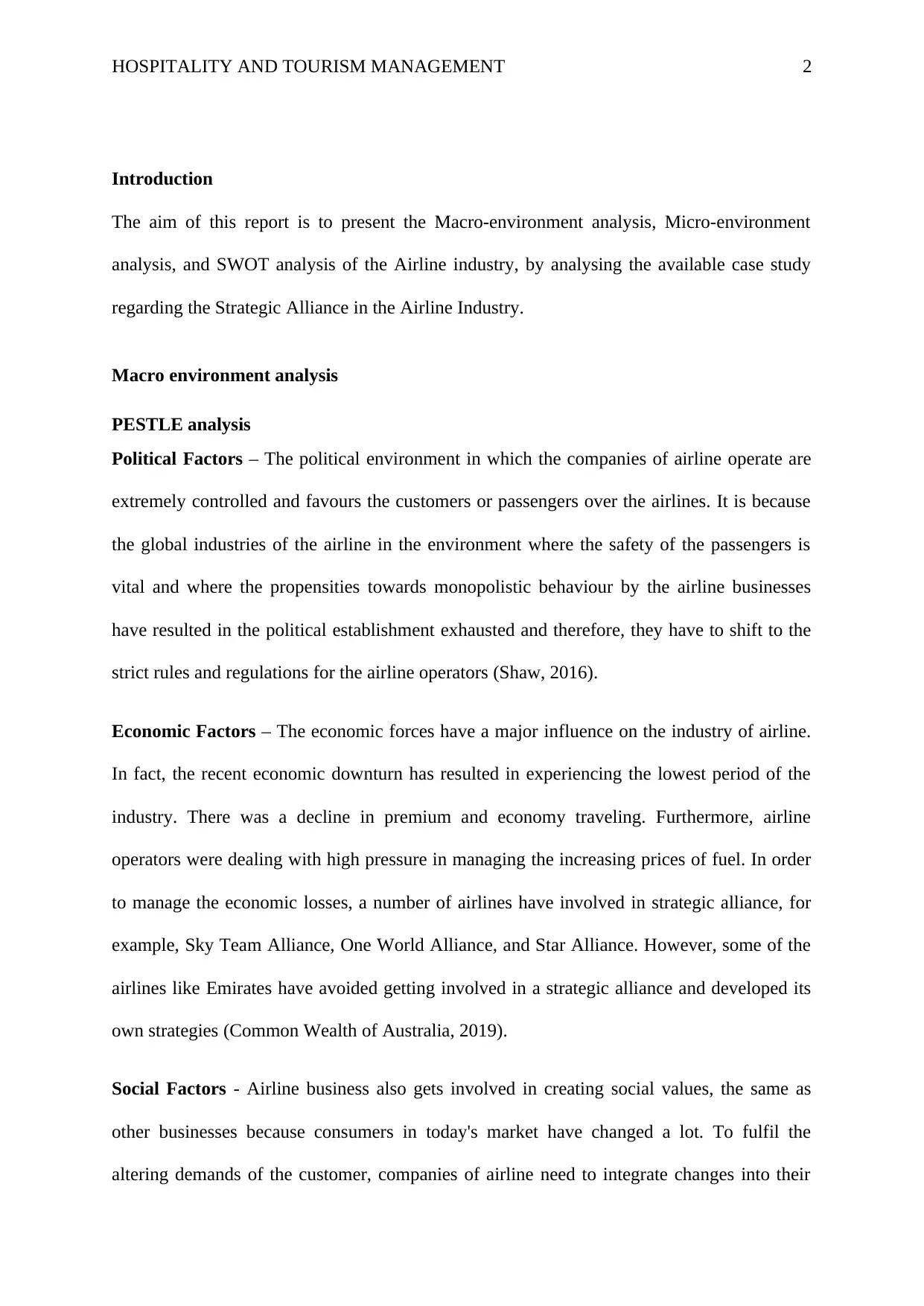
HOSPITALITY AND TOURISM MANAGEMENT 2
Introduction
The aim of this report is to present the Macro-environment analysis, Micro-environment
analysis, and SWOT analysis of the Airline industry, by analysing the available case study
regarding the Strategic Alliance in the Airline Industry.
Macro environment analysis
PESTLE analysis
Political Factors – The political environment in which the companies of airline operate are
extremely controlled and favours the customers or passengers over the airlines. It is because
the global industries of the airline in the environment where the safety of the passengers is
vital and where the propensities towards monopolistic behaviour by the airline businesses
have resulted in the political establishment exhausted and therefore, they have to shift to the
strict rules and regulations for the airline operators (Shaw, 2016).
Economic Factors – The economic forces have a major influence on the industry of airline.
In fact, the recent economic downturn has resulted in experiencing the lowest period of the
industry. There was a decline in premium and economy traveling. Furthermore, airline
operators were dealing with high pressure in managing the increasing prices of fuel. In order
to manage the economic losses, a number of airlines have involved in strategic alliance, for
example, Sky Team Alliance, One World Alliance, and Star Alliance. However, some of the
airlines like Emirates have avoided getting involved in a strategic alliance and developed its
own strategies (Common Wealth of Australia, 2019).
Social Factors - Airline business also gets involved in creating social values, the same as
other businesses because consumers in today's market have changed a lot. To fulfil the
altering demands of the customer, companies of airline need to integrate changes into their
Introduction
The aim of this report is to present the Macro-environment analysis, Micro-environment
analysis, and SWOT analysis of the Airline industry, by analysing the available case study
regarding the Strategic Alliance in the Airline Industry.
Macro environment analysis
PESTLE analysis
Political Factors – The political environment in which the companies of airline operate are
extremely controlled and favours the customers or passengers over the airlines. It is because
the global industries of the airline in the environment where the safety of the passengers is
vital and where the propensities towards monopolistic behaviour by the airline businesses
have resulted in the political establishment exhausted and therefore, they have to shift to the
strict rules and regulations for the airline operators (Shaw, 2016).
Economic Factors – The economic forces have a major influence on the industry of airline.
In fact, the recent economic downturn has resulted in experiencing the lowest period of the
industry. There was a decline in premium and economy traveling. Furthermore, airline
operators were dealing with high pressure in managing the increasing prices of fuel. In order
to manage the economic losses, a number of airlines have involved in strategic alliance, for
example, Sky Team Alliance, One World Alliance, and Star Alliance. However, some of the
airlines like Emirates have avoided getting involved in a strategic alliance and developed its
own strategies (Common Wealth of Australia, 2019).
Social Factors - Airline business also gets involved in creating social values, the same as
other businesses because consumers in today's market have changed a lot. To fulfil the
altering demands of the customer, companies of airline need to integrate changes into their
⊘ This is a preview!⊘
Do you want full access?
Subscribe today to unlock all pages.

Trusted by 1+ million students worldwide
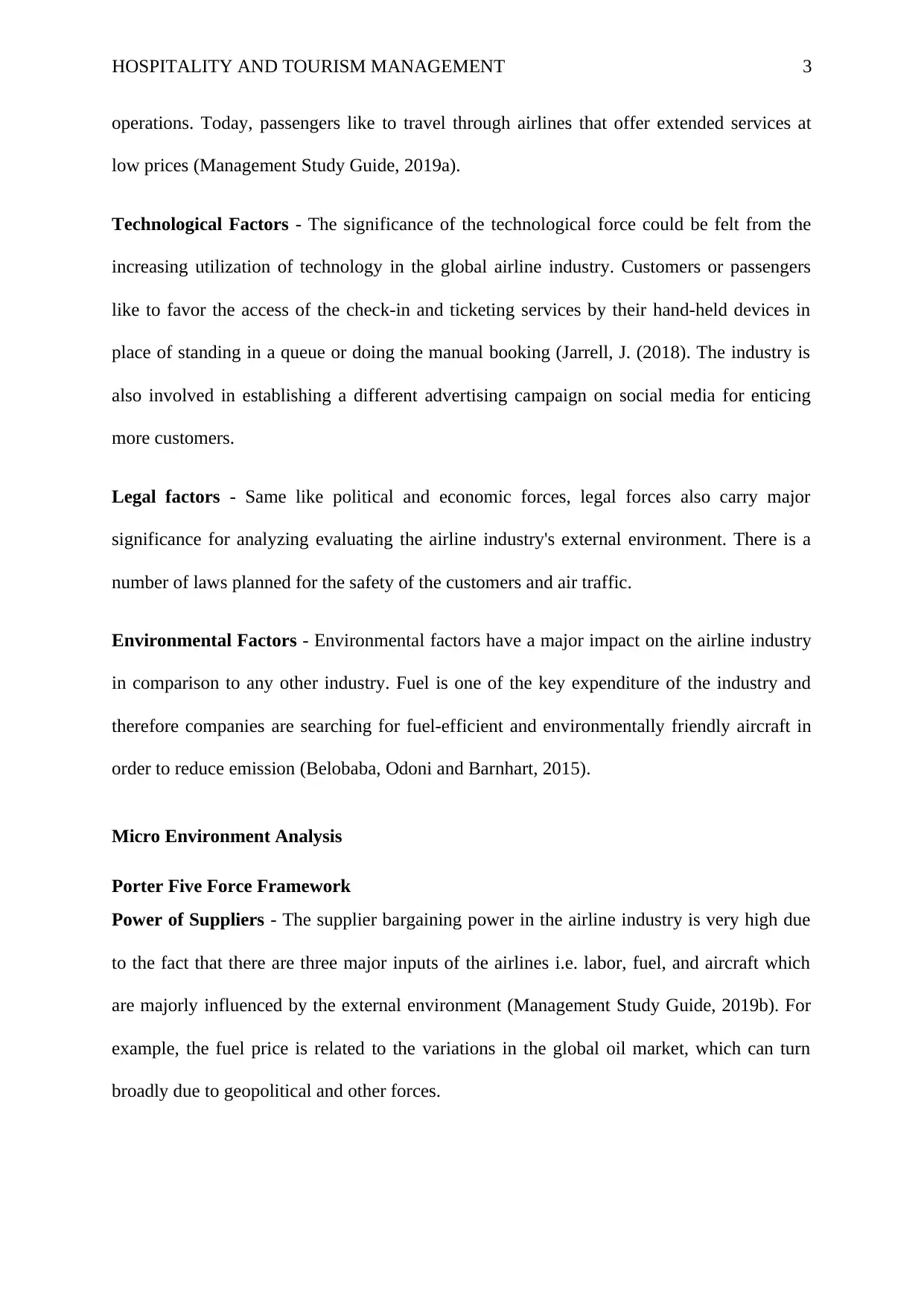
HOSPITALITY AND TOURISM MANAGEMENT 3
operations. Today, passengers like to travel through airlines that offer extended services at
low prices (Management Study Guide, 2019a).
Technological Factors - The significance of the technological force could be felt from the
increasing utilization of technology in the global airline industry. Customers or passengers
like to favor the access of the check-in and ticketing services by their hand-held devices in
place of standing in a queue or doing the manual booking (Jarrell, J. (2018). The industry is
also involved in establishing a different advertising campaign on social media for enticing
more customers.
Legal factors - Same like political and economic forces, legal forces also carry major
significance for analyzing evaluating the airline industry's external environment. There is a
number of laws planned for the safety of the customers and air traffic.
Environmental Factors - Environmental factors have a major impact on the airline industry
in comparison to any other industry. Fuel is one of the key expenditure of the industry and
therefore companies are searching for fuel-efficient and environmentally friendly aircraft in
order to reduce emission (Belobaba, Odoni and Barnhart, 2015).
Micro Environment Analysis
Porter Five Force Framework
Power of Suppliers - The supplier bargaining power in the airline industry is very high due
to the fact that there are three major inputs of the airlines i.e. labor, fuel, and aircraft which
are majorly influenced by the external environment (Management Study Guide, 2019b). For
example, the fuel price is related to the variations in the global oil market, which can turn
broadly due to geopolitical and other forces.
operations. Today, passengers like to travel through airlines that offer extended services at
low prices (Management Study Guide, 2019a).
Technological Factors - The significance of the technological force could be felt from the
increasing utilization of technology in the global airline industry. Customers or passengers
like to favor the access of the check-in and ticketing services by their hand-held devices in
place of standing in a queue or doing the manual booking (Jarrell, J. (2018). The industry is
also involved in establishing a different advertising campaign on social media for enticing
more customers.
Legal factors - Same like political and economic forces, legal forces also carry major
significance for analyzing evaluating the airline industry's external environment. There is a
number of laws planned for the safety of the customers and air traffic.
Environmental Factors - Environmental factors have a major impact on the airline industry
in comparison to any other industry. Fuel is one of the key expenditure of the industry and
therefore companies are searching for fuel-efficient and environmentally friendly aircraft in
order to reduce emission (Belobaba, Odoni and Barnhart, 2015).
Micro Environment Analysis
Porter Five Force Framework
Power of Suppliers - The supplier bargaining power in the airline industry is very high due
to the fact that there are three major inputs of the airlines i.e. labor, fuel, and aircraft which
are majorly influenced by the external environment (Management Study Guide, 2019b). For
example, the fuel price is related to the variations in the global oil market, which can turn
broadly due to geopolitical and other forces.
Paraphrase This Document
Need a fresh take? Get an instant paraphrase of this document with our AI Paraphraser
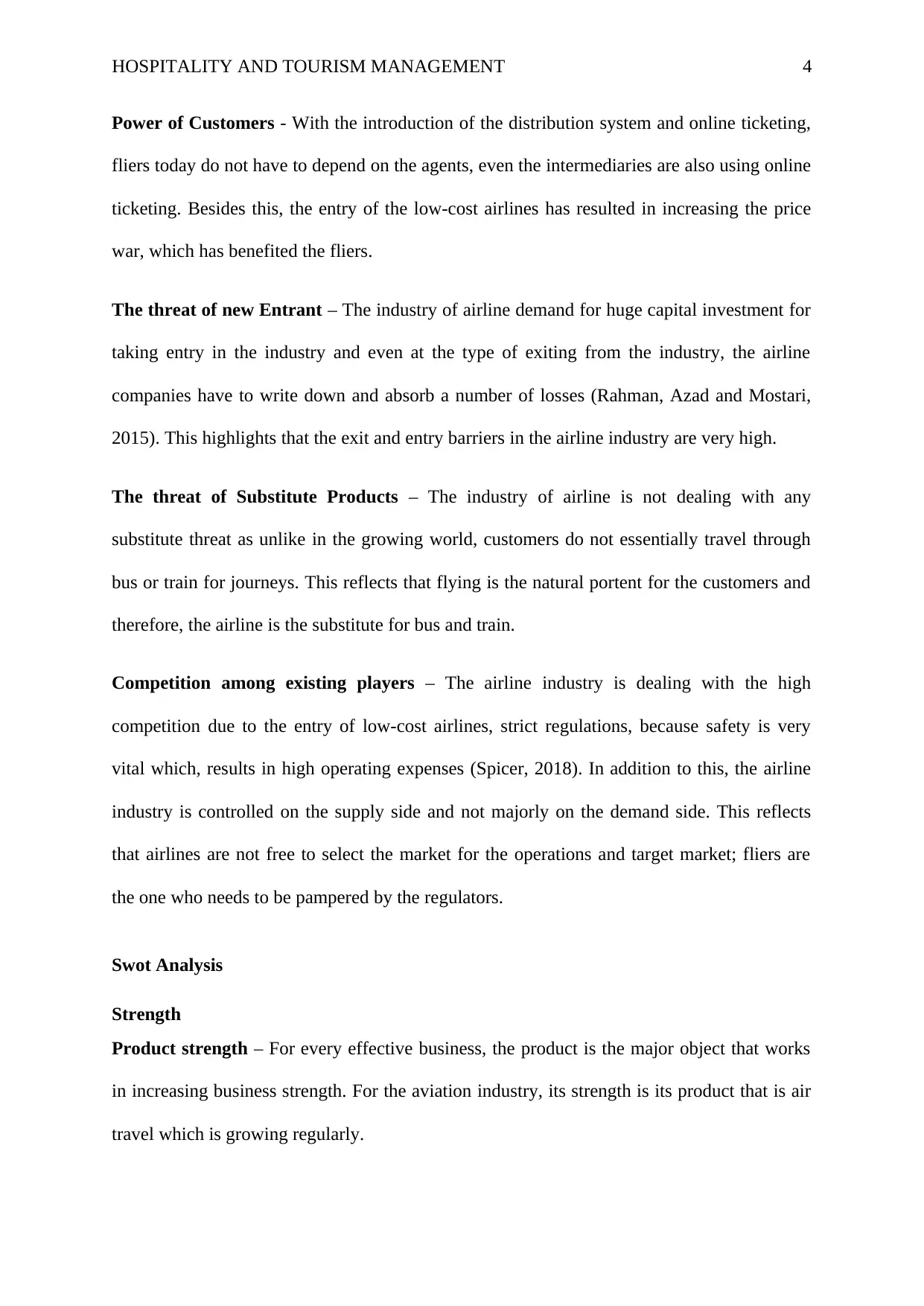
HOSPITALITY AND TOURISM MANAGEMENT 4
Power of Customers - With the introduction of the distribution system and online ticketing,
fliers today do not have to depend on the agents, even the intermediaries are also using online
ticketing. Besides this, the entry of the low-cost airlines has resulted in increasing the price
war, which has benefited the fliers.
The threat of new Entrant – The industry of airline demand for huge capital investment for
taking entry in the industry and even at the type of exiting from the industry, the airline
companies have to write down and absorb a number of losses (Rahman, Azad and Mostari,
2015). This highlights that the exit and entry barriers in the airline industry are very high.
The threat of Substitute Products – The industry of airline is not dealing with any
substitute threat as unlike in the growing world, customers do not essentially travel through
bus or train for journeys. This reflects that flying is the natural portent for the customers and
therefore, the airline is the substitute for bus and train.
Competition among existing players – The airline industry is dealing with the high
competition due to the entry of low-cost airlines, strict regulations, because safety is very
vital which, results in high operating expenses (Spicer, 2018). In addition to this, the airline
industry is controlled on the supply side and not majorly on the demand side. This reflects
that airlines are not free to select the market for the operations and target market; fliers are
the one who needs to be pampered by the regulators.
Swot Analysis
Strength
Product strength – For every effective business, the product is the major object that works
in increasing business strength. For the aviation industry, its strength is its product that is air
travel which is growing regularly.
Power of Customers - With the introduction of the distribution system and online ticketing,
fliers today do not have to depend on the agents, even the intermediaries are also using online
ticketing. Besides this, the entry of the low-cost airlines has resulted in increasing the price
war, which has benefited the fliers.
The threat of new Entrant – The industry of airline demand for huge capital investment for
taking entry in the industry and even at the type of exiting from the industry, the airline
companies have to write down and absorb a number of losses (Rahman, Azad and Mostari,
2015). This highlights that the exit and entry barriers in the airline industry are very high.
The threat of Substitute Products – The industry of airline is not dealing with any
substitute threat as unlike in the growing world, customers do not essentially travel through
bus or train for journeys. This reflects that flying is the natural portent for the customers and
therefore, the airline is the substitute for bus and train.
Competition among existing players – The airline industry is dealing with the high
competition due to the entry of low-cost airlines, strict regulations, because safety is very
vital which, results in high operating expenses (Spicer, 2018). In addition to this, the airline
industry is controlled on the supply side and not majorly on the demand side. This reflects
that airlines are not free to select the market for the operations and target market; fliers are
the one who needs to be pampered by the regulators.
Swot Analysis
Strength
Product strength – For every effective business, the product is the major object that works
in increasing business strength. For the aviation industry, its strength is its product that is air
travel which is growing regularly.

HOSPITALITY AND TOURISM MANAGEMENT 5
Wife geographic presence – Today, the trend of strategic alliance in the aviation industry is
gaining huge importance. Because alliance between different airline business offer a wide
network of dealing and associates network that not just support in offering services to the
consumers but also help in handling competitive challenges in the Strategy and Execution
industry (Star Alliance, 2014).
Weaknesses
Declining market share – There is a number of players in the Aviation industry which are
putting their maximum efforts to increase market share, and for that offering different
services and discounts to the customers. This is resulting in putting a limit on the market
share or even results in declining market share due to the entry of low-cost airlines.
Opportunities
Accessing technological advancement – The introduction of advanced technologies in
different industries, support in increasing productivity and reducing cost (Robosoft
Technologies, 2017). Same in the airline industry, the businesses through strategic alliance
must get involved in the research and development for the introduction of fuel-efficient
aircraft and substitutes of fuels in order to increase productivity and reduce cost.
Threats
Increasing competitive pressure – The aviation industry is dealing with intense competition
due to the entry of low-cost airlines and the introduction of strict laws by the government for
the safety of passengers.
Conclusion
The report above is presenting the present condition of the global Aviation industry and
strategic alliance taking place within the industry. From the analysis, it has been identified
Wife geographic presence – Today, the trend of strategic alliance in the aviation industry is
gaining huge importance. Because alliance between different airline business offer a wide
network of dealing and associates network that not just support in offering services to the
consumers but also help in handling competitive challenges in the Strategy and Execution
industry (Star Alliance, 2014).
Weaknesses
Declining market share – There is a number of players in the Aviation industry which are
putting their maximum efforts to increase market share, and for that offering different
services and discounts to the customers. This is resulting in putting a limit on the market
share or even results in declining market share due to the entry of low-cost airlines.
Opportunities
Accessing technological advancement – The introduction of advanced technologies in
different industries, support in increasing productivity and reducing cost (Robosoft
Technologies, 2017). Same in the airline industry, the businesses through strategic alliance
must get involved in the research and development for the introduction of fuel-efficient
aircraft and substitutes of fuels in order to increase productivity and reduce cost.
Threats
Increasing competitive pressure – The aviation industry is dealing with intense competition
due to the entry of low-cost airlines and the introduction of strict laws by the government for
the safety of passengers.
Conclusion
The report above is presenting the present condition of the global Aviation industry and
strategic alliance taking place within the industry. From the analysis, it has been identified
⊘ This is a preview!⊘
Do you want full access?
Subscribe today to unlock all pages.

Trusted by 1+ million students worldwide
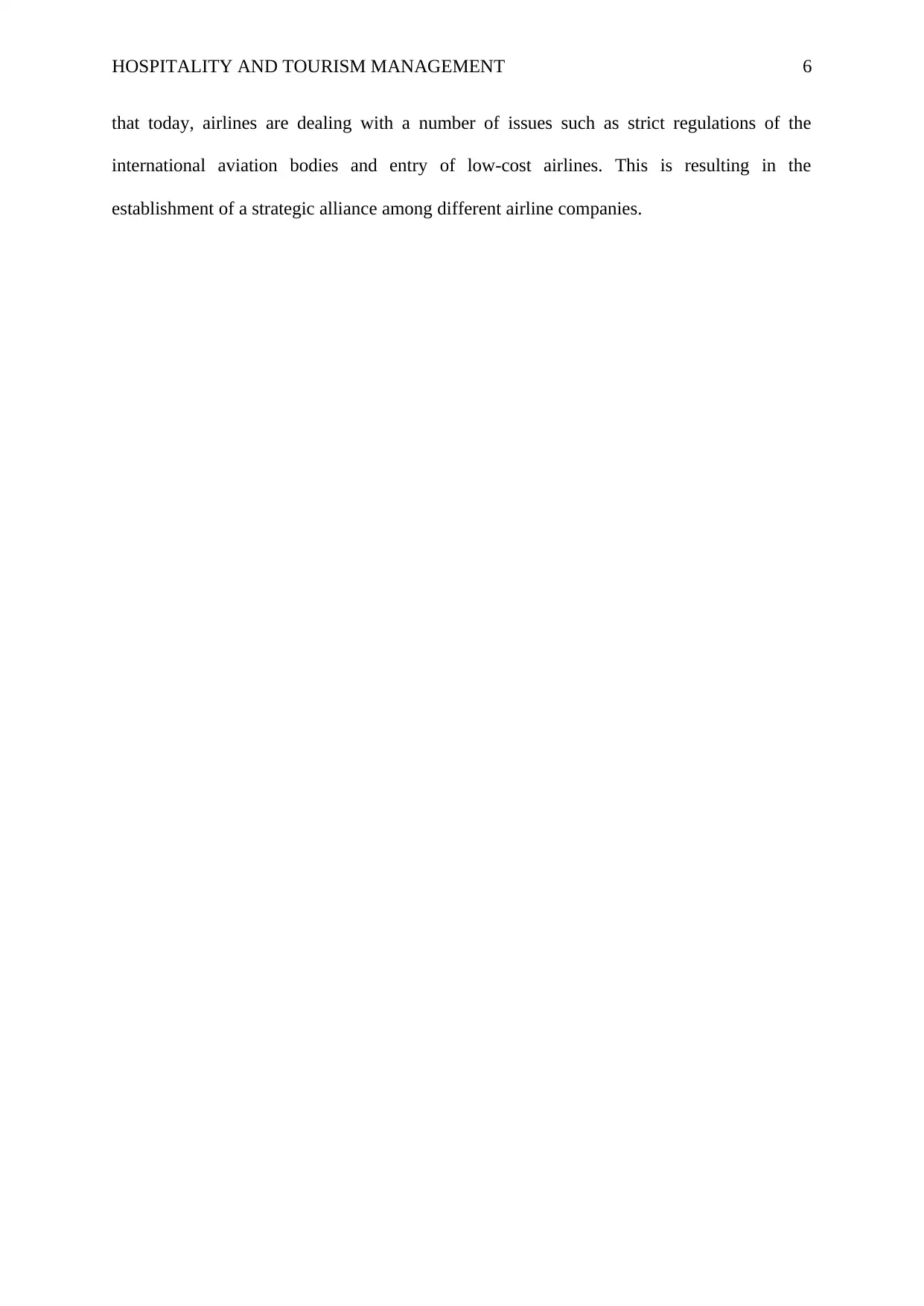
HOSPITALITY AND TOURISM MANAGEMENT 6
that today, airlines are dealing with a number of issues such as strict regulations of the
international aviation bodies and entry of low-cost airlines. This is resulting in the
establishment of a strategic alliance among different airline companies.
that today, airlines are dealing with a number of issues such as strict regulations of the
international aviation bodies and entry of low-cost airlines. This is resulting in the
establishment of a strategic alliance among different airline companies.
Paraphrase This Document
Need a fresh take? Get an instant paraphrase of this document with our AI Paraphraser
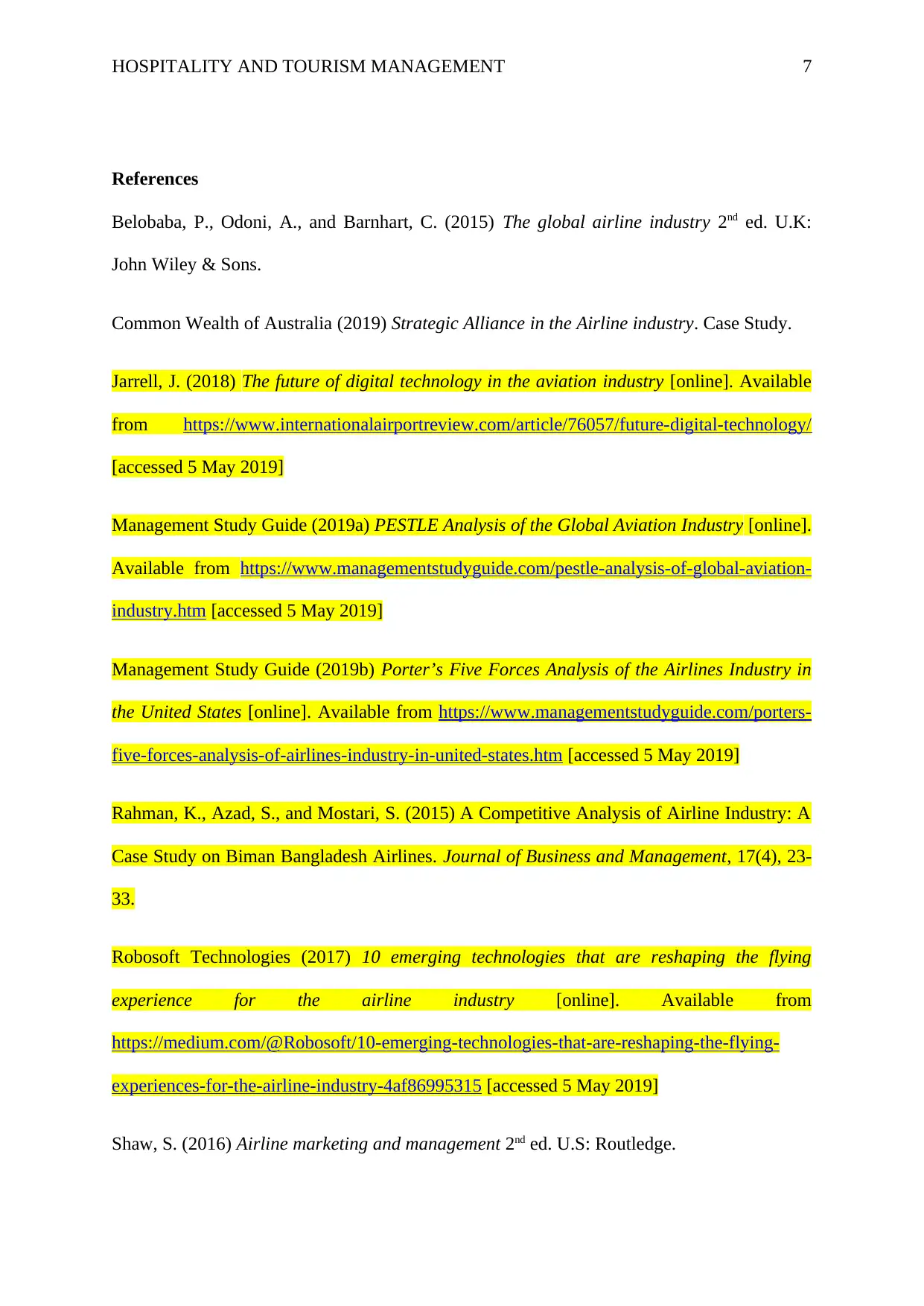
HOSPITALITY AND TOURISM MANAGEMENT 7
References
Belobaba, P., Odoni, A., and Barnhart, C. (2015) The global airline industry 2nd ed. U.K:
John Wiley & Sons.
Common Wealth of Australia (2019) Strategic Alliance in the Airline industry. Case Study.
Jarrell, J. (2018) The future of digital technology in the aviation industry [online]. Available
from https://www.internationalairportreview.com/article/76057/future-digital-technology/
[accessed 5 May 2019]
Management Study Guide (2019a) PESTLE Analysis of the Global Aviation Industry [online].
Available from https://www.managementstudyguide.com/pestle-analysis-of-global-aviation-
industry.htm [accessed 5 May 2019]
Management Study Guide (2019b) Porter’s Five Forces Analysis of the Airlines Industry in
the United States [online]. Available from https://www.managementstudyguide.com/porters-
five-forces-analysis-of-airlines-industry-in-united-states.htm [accessed 5 May 2019]
Rahman, K., Azad, S., and Mostari, S. (2015) A Competitive Analysis of Airline Industry: A
Case Study on Biman Bangladesh Airlines. Journal of Business and Management, 17(4), 23-
33.
Robosoft Technologies (2017) 10 emerging technologies that are reshaping the flying
experience for the airline industry [online]. Available from
https://medium.com/@Robosoft/10-emerging-technologies-that-are-reshaping-the-flying-
experiences-for-the-airline-industry-4af86995315 [accessed 5 May 2019]
Shaw, S. (2016) Airline marketing and management 2nd ed. U.S: Routledge.
References
Belobaba, P., Odoni, A., and Barnhart, C. (2015) The global airline industry 2nd ed. U.K:
John Wiley & Sons.
Common Wealth of Australia (2019) Strategic Alliance in the Airline industry. Case Study.
Jarrell, J. (2018) The future of digital technology in the aviation industry [online]. Available
from https://www.internationalairportreview.com/article/76057/future-digital-technology/
[accessed 5 May 2019]
Management Study Guide (2019a) PESTLE Analysis of the Global Aviation Industry [online].
Available from https://www.managementstudyguide.com/pestle-analysis-of-global-aviation-
industry.htm [accessed 5 May 2019]
Management Study Guide (2019b) Porter’s Five Forces Analysis of the Airlines Industry in
the United States [online]. Available from https://www.managementstudyguide.com/porters-
five-forces-analysis-of-airlines-industry-in-united-states.htm [accessed 5 May 2019]
Rahman, K., Azad, S., and Mostari, S. (2015) A Competitive Analysis of Airline Industry: A
Case Study on Biman Bangladesh Airlines. Journal of Business and Management, 17(4), 23-
33.
Robosoft Technologies (2017) 10 emerging technologies that are reshaping the flying
experience for the airline industry [online]. Available from
https://medium.com/@Robosoft/10-emerging-technologies-that-are-reshaping-the-flying-
experiences-for-the-airline-industry-4af86995315 [accessed 5 May 2019]
Shaw, S. (2016) Airline marketing and management 2nd ed. U.S: Routledge.
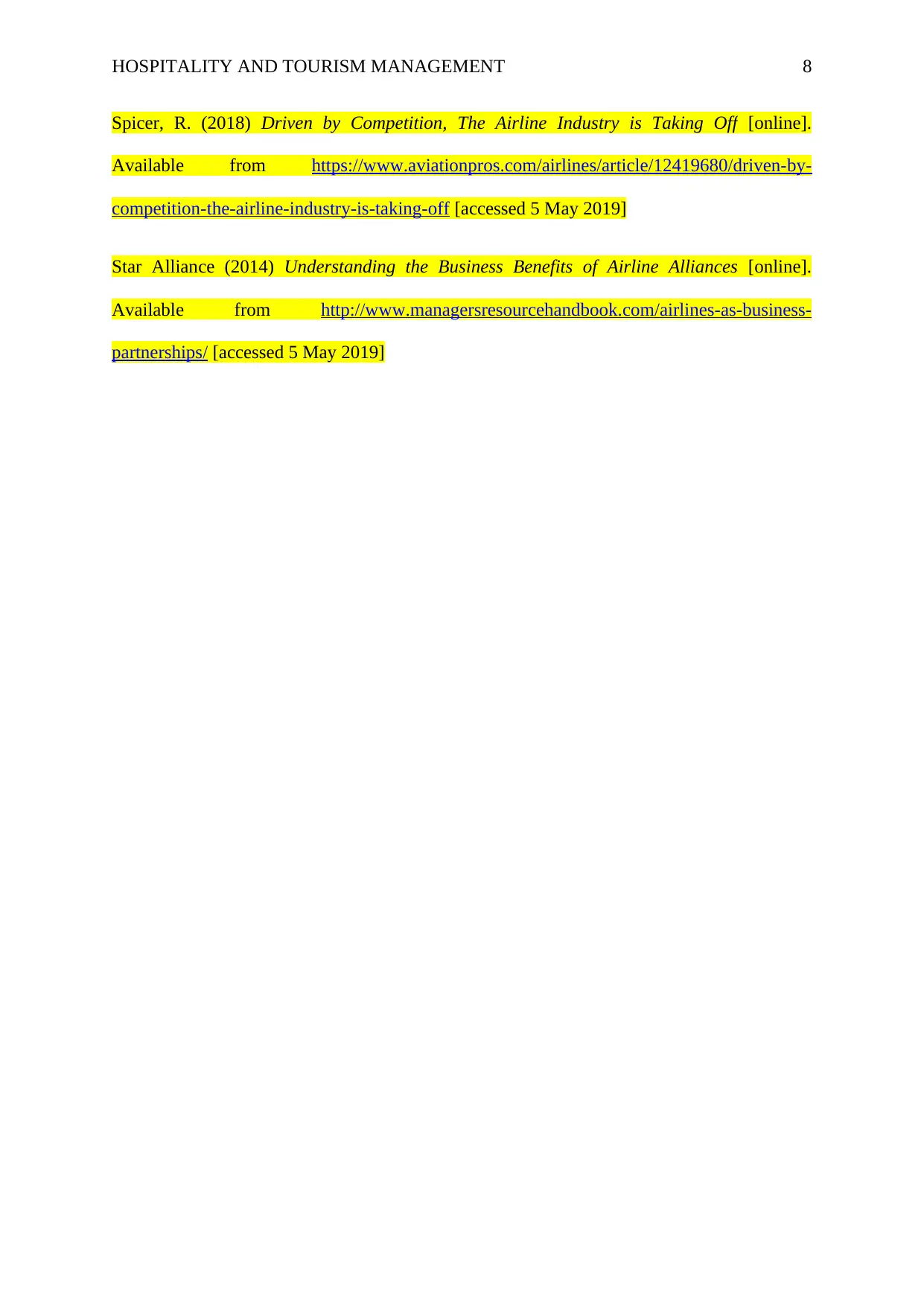
HOSPITALITY AND TOURISM MANAGEMENT 8
Spicer, R. (2018) Driven by Competition, The Airline Industry is Taking Off [online].
Available from https://www.aviationpros.com/airlines/article/12419680/driven-by-
competition-the-airline-industry-is-taking-off [accessed 5 May 2019]
Star Alliance (2014) Understanding the Business Benefits of Airline Alliances [online].
Available from http://www.managersresourcehandbook.com/airlines-as-business-
partnerships/ [accessed 5 May 2019]
Spicer, R. (2018) Driven by Competition, The Airline Industry is Taking Off [online].
Available from https://www.aviationpros.com/airlines/article/12419680/driven-by-
competition-the-airline-industry-is-taking-off [accessed 5 May 2019]
Star Alliance (2014) Understanding the Business Benefits of Airline Alliances [online].
Available from http://www.managersresourcehandbook.com/airlines-as-business-
partnerships/ [accessed 5 May 2019]
⊘ This is a preview!⊘
Do you want full access?
Subscribe today to unlock all pages.

Trusted by 1+ million students worldwide
1 out of 9
Related Documents
Your All-in-One AI-Powered Toolkit for Academic Success.
+13062052269
info@desklib.com
Available 24*7 on WhatsApp / Email
![[object Object]](/_next/static/media/star-bottom.7253800d.svg)
Unlock your academic potential
Copyright © 2020–2025 A2Z Services. All Rights Reserved. Developed and managed by ZUCOL.





